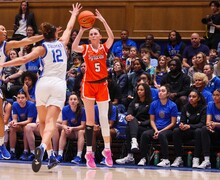South Florida’s fast-paced offense provides latest test for No. 21 Syracuse
Yuki Mizuma | Staff Photographer
Syracuse center Kayla Alexander played just more than five minutes in the first half of the Orange's 58-45, contributing to SU's slow start.
Just more than five minutes into Syracuse’s win over Rutgers on Tuesday night, Kayla Alexander was whistled for her second foul. The center trotted to the bench, where she sat for the remainder of the half.
Shakeya Leary entered and held her own on the defensive end, but Syracuse went into halftime trailing 19-15.
“Bad shooting and turnovers,” SU head coach Quentin Hillsman said about what contributed to the slow start. “You can’t explain it. I thought we had a lot of layups, a lot of open shots we just missed. But we’ve got a tough team.”
Alexander’s absence factored into the latest of the No. 21 Orange’s all-too-familiar slow starts, but it’s the shooting and turnovers that have caused it all season long. Though Syracuse (22-3, 10-2 Big East) has made it most of the way through conference play with barely a scratch, the best start in school history hasn’t been easy. The Orange led Georgetown by just four at the half before winning by 30, and held just a nine-point lead against Seton Hall before winning by 31.
Avoiding another slow start will be imperative when SU faces South Florida (18-7, 7-5) on Saturday at 2 p.m. in Tampa, Fla. The Bulls play at a high tempo and average more than 72 points per game, less than three points fewer than Syracuse. The brainchild of USF head coach Jose Fernandez, South Florida’s fast-paced offensive assault has been enough to keep Hillsman up at night.
“They play really fast. I was talking to him last week and I was watching them on film and I just texted him and said, ‘You guys play so fast,’” Hillsman said. “It was like 1 o’clock in the morning and he texted back and said, ‘You should sleep.’ They just really play fast-paced basketball.”
The Scarlet Knights’, Hoyas’ and Pirates’ offenses all rank outside the top 125, so climbing back wasn’t much of an issue. But a slow start like one in any of those three games could doom the Orange and force it into a game of catchup against the Bulls, who knocked off No. 12 Louisville on Wednesday night.
Aside from Alexander’s absence, the first-half struggles were the same as they’ve often been this season.
“The first half, we turned the ball over a lot,” SU guard Brianna Butler said. “We also weren’t hitting shots we usually make.”
Syracuse shot just 20 percent from the field in the first half of its 58-45 victory over RU, and turned the ball over 14 times. The shots started to fall in the second half, especially from beyond the arc, where the Orange made 5-of-8 after a 1-for-12 first half. But the stark difference was in ball control. SU turned the ball over just three times in the second half and scored 43 points, despite only improving its shooting percentage to 32.4 in the final frame.
As a whole, Syracuse has scored nearly 150 more points in the second half of games this season than it has in the first. The slow starts have been discouraging, but not any more than the second halves have been encouraging.
“We’re closing games, so that’s all I care about right now,” Alexander said. “Slow starts might need improvement, but winning games? That’s what matters right now.”
Alexander simply shook her head when asked if she could identify the root of the Orange’s slow starts. Searching for an answer, she was temporarily rendered speechless.
Then SU guard Rachel Coffey, who followed up a five-point, four-turnover first half with a 12-point, one-turnover second against the Scarlet Knights, interjected to share her insight on the recurring problem.
“I think it’s all in our head, basically,” Coffey said. “It happens — people come out slow, people come out fast and end up playing bad in the second half. But this is how we play. We’re still winning, so I’m not complaining.”
Published on February 21, 2013 at 2:01 am
Contact David: dbwilson@syr.edu | @DBWilson2





